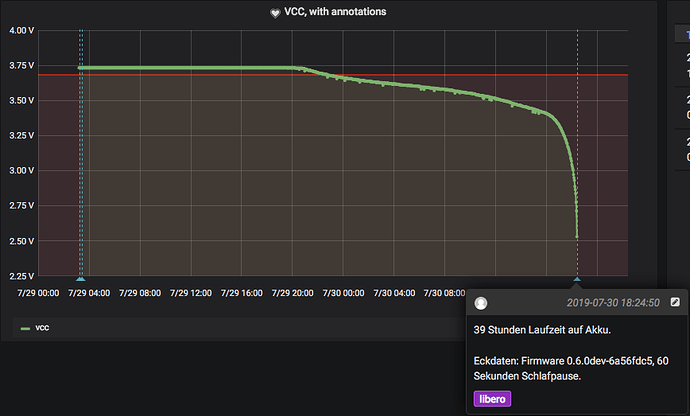@MKO vielleicht könntest du mit der aktuellen firmware nochmal nachmessen, traue meinen Werten nicht ganz bzw. wäre gut, wenn sie jemand zweites bestätigt bevor wir hier zeitintensive Optimierungen nachschieben.
Du hast gar kein Messgerät, oder? Voltcraft VC175
Messbereich A/DC min. 0.1 µA
hier meine settings.py
"""Datalogger configuration"""
# General settings.
main = {
# Measurement interval in seconds.
# TODO: Please note this is not the _real thing_ yet at it will just use
# this value to apply to ``time.sleep()`` after each duty cycle.
'interval': 40.0,
# Whether to use deep sleep between measurement cycles.
'deepsleep': True,
# Configure logging.
'logging': {
# Enable or disable logging completely.
'enabled': True,
# Log configuration settings at system startup.
'configuration': True,
},
# Configure Watchdog.
'watchdog': {
# Enable or disable Watchdog completely.
'enabled': False,
# Watchdog timeout in milliseconds.
'timeout': 20000,
},
# Configure RGB-LED.
'rgb_led': {
'heartbeat': False,
},
}
# Interface settings.
interfaces = {
'uart0': {
'terminal': True,
}
}
# Networking configuration.
networking = {
'wifi': {
# WiFi stations to connect to in STA mode.
'stations': [
# Variant 1: Use DHCP.
# Variant 1a: Straight forward.
{'ssid': 'your-ssid', 'password': 'your-pw'},
# Variant 1b: Configure timeout (default: 15 seconds).
# Configure this to decrease or increase the maximum time in
# seconds to wait for the connection to succeed.
#{'ssid': 'FooBar', 'password': 'SECRET', 'timeout': 5.0},
# Variant 2: Using static IP address.
#{
# 'ssid': 'FooBar',
# 'password': 'SECRET',
# # Use static network configuration (ip, subnet_mask, gateway, DNS_server).
# 'ifconfig': ('192.168.42.42', '255.255.255.0', '192.168.42.1', '192.168.42.1'),
#},
],
},
}
# Telemetry configuration.
telemetry = {
'targets': [
# Hiveeyes telemetry: JSON over MQTT
{
# Enable/disable this telemetry target.
'enabled': True,
# Define telemetry endpoint and address information.
'endpoint': 'mqtt://swarm.hiveeyes.org',
'topology': 'mqttkit',
'address': {
"realm": "hiveeyes",
"network": "testdrive",
"gateway": "area-005",
"node": "fipy-cg-01",
},
},
# Beep telemetry: JSON over HTTP
{
# Enable/disable this telemetry target.
'enabled': True,
# Define telemetry endpoint and address information.
'endpoint': 'https://bee-observer.org/api/sensors',
'topology': 'beep-bob',
'data': {
'key': 'my-key',
},
},
],
}
# Sensor configuration.
sensors = {
'system': {
# Adjust voltage divider resistor values matching the board.
#
# See also
# - https://forum.pycom.io/topic/3776/adc-use-to-measure-battery-level-vin-level
# - https://github.com/hiveeyes/hiveeyes-micropython-firmware/issues/5
# - https://community.hiveeyes.org/t/batterieuberwachung-voltage-divider-und-attenuation-fur-microypthon-firmware/2128
#
# As a reference (all readings using 6dB attenuation unless otherwise noted):
#
# - Pycom Expansion board v3.0: 115 kΩ / 56 kΩ
# - Pycom Expansion board v3.1: 1 MΩ / 1 MΩ
# - Pycom Expansion board v3.2: 1 MΩ / 1 MΩ
# - BOB-HAT-V5: 1 MΩ / 470 kΩ or 220 kΩ
# - BOB-SHIELD: 10 MΩ / 2 MΩ
# - Air Quality monitor: 100kΩ / 47 kΩ, measured with 2.5dB attenuation
# These settings are matching the resistor values of the Pycom Expansion Board 3.1 and 3.2.
'vcc': {
'pin': 'P16',
# Main resistor value (R1).
'resistor_r1': 10,
# Resistor between input pin and ground (R2).
'resistor_r2': 2,
},
# Settings for button events, e.g. through touch pads.
'buttons': {
'enabled': False,
},
},
'registry': {
'hx711': {
'address': 0x00,
'pin_dout': 'P22',
'pin_pdsck': 'P21',
'scale': -22479.0,
'offset': 32423.0,
},
'ds18x20': {
'bus': 'onewire:0',
},
'bme280': {
'bus': 'i2c:0',
'address': 0x77,
},
},
'busses': [
{
"family": "i2c",
"number": 0,
"enabled": True,
"pin_sda": "P9",
"pin_scl": "P10",
},
{
"family": "onewire",
"number": 0,
"enabled": True,
"pin_data": "P11",
},
]
}
# Map sensor field names to telemetry field names.
# Right now, please adapt this according to your sensor configuration by
# looking at the console output of the line
# `[terkin.datalogger] INFO: Sensor data`. Thanks!
#
# Remark:
# This will be replaced by runtime configuration through
# HTTP API and captive portal.
sensor_telemetry_map = {
"_version": "1.0.0",
"temperature.0x77.i2c:0": "t",
"humidity.0x77.i2c:0": "h",
"pressure.0x77.i2c:0": "p",
"weight.0": "weight",
"temperature.28ff641d8fd18ab0.onewire:0": "t_i_1",
"temperature.28ff641d8fd4d5d5.onewire:0": "t_i_2",
"temperature.28ff641d8fd833ac.onewire:0": "t_i_3",
"temperature.28ff641d8fd8778b.onewire:0": "t_i_4",
"temperature.28ff641d8fd922ab.onewire:0": "t_i_5",
"system.temperature": "t_i_6",
}
Vielleicht könntest du noch 2 Sätze zu UART0 schreiben, war mir in der Konfig nicht klar was das macht.
LEDs brauchen bei dauer-an pi-x-daumen 20 mA und mehr, klar bringt es was die auszuschalten!
Kombinierte Effekte würde ich nicht erwarten, eher additive.
